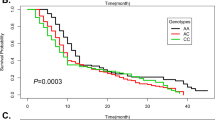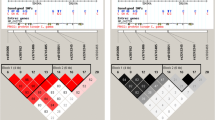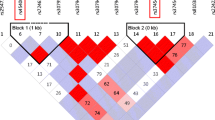Abstract
Despite the knowledge on many genetic variants present in osteosarcoma, the complexity of this disease precludes placing its biology into a simple conceptual framework. RECQL is a DNA helicase involved in DNA mismatch repair and has been reported to be associated with many human cancers. We aimed to investigate the association of RECQL genetic polymorphism with osteosarcoma in a Chinese population. We selected three polymorphisms of the RECQL5 gene (rs820196, rs820200, and rs4789223) in the present study. TaqMan method was utilized for genotyping these three SNPs in 212 patients with osteosarcoma and 240 age- and sex-matched noncancer controls. In our study, we found that CC genotype in rs820196 (17.5 vs 8.3 %, P = 0.005) and AA genotype in rs4789223 (21.7 vs 14.2, P < 0.001) were more frequent in osteosarcoma group compared to the control group, respectively. We also found that the C allele of rs820196 (OR = 1.492, 95 % CI 1.138∼1.951; P = 0.004) and A allele of rs4789223 (OR = 1.767, 95 % CI: 1.354 ∼ 2.301; P < 0.001) were common in the osteosarcoma patients than those in the control subjects, respectively. Haplotype analysis showed that TTA (OR = 3.469, 95 % CI 1.798∼6.695; P < 0.001) was associated with increased risk for osteosarcoma. However, the TTG (OR = 0.578, 95 % CI 0.442∼0.756) was associated with decreased risk for osteosarcoma. Our results suggested that RECQL5 genetic polymorphisms were associated with osteosarcoma in a Chinese population.

Similar content being viewed by others
References
Dorfman HD, Czerniak B. Bone cancers. Cancer. 1995;75:203–10.
Mirabello L, Troisi RJ, Savage SA. Osteosarcoma incidence and survival rates from 1973 to 2004: data from the Surveillance, Epidemiology, and End Results Program. Cancer. 2009;115:1531–43.
Hameed M, Dorfman H. Primary malignant bone tumors—recent developments. Semin Diagn Pathol. 2011;28:86–101.
Wittig JC, Bickels J, Priebat D, Jelinek J, Kellar-Graney K, Shmookler B, et al. Osteosarcoma: a multidisciplinary approach to diagnosis and treatment. Am Fam Physician. 2002;65:1123–32.
Kager L, Zoubek A, Potschger U, et al. Primary metastatic osteosarcoma: presentation and outcome of patients treated on neoadjuvant Cooperative Osteosarcoma Study Group protocols. J Clin Oncol. 2003;21:2011–8.
Zhou Y, Liu B, Wang M, Ni J. Endothelin-1 gene polymorphisms and risk of chemoresistant pediatric osteosarcoma. Pediatr Blood Cancer. 2013. doi:10.1002/pbc.24790.
Wang L, Liu Z, Jing P, Shao L, Chen L, He X, Gong W. Effects of murine double minute 2 polymorphisms on the risk and survival of osteosarcoma: a systemic review and meta-analysis. Tumour Biol. 2013. doi:10.1007/s13277-013-1227-8
He M, Wang Z, Zhao J, Chen Y, Wu Y. COL1A1 polymorphism is associated with risks of osteosarcoma susceptibility and death. Tumour Biol. 2013. doi:10.1007/s13277-013-1172-6.
Wang J, Nong L, Wei Y, Qin S, Zhou Y, Tang Y. Association of interleukin-12 polymorphisms and serum IL-12p40 levels with osteosarcoma risk. DNA Cell Biol. 2013;32:605–10. doi:10.1089/dna.2013.2098.
He J, Wang J, Wang D, Dai S, Yv T, Chen P, Ma R, Diao C, Lv G (2013) Association analysis between genetic variants of MDM2 gene and osteosarcoma susceptibility in Chinese. Endocr J. (in press).
Salinas-Souza C, Petrilli AS, de Toledo SR. Glutathione S-transferase polymorphisms in osteosarcoma patients. Pharmacogenet Genomics. 2010;20:507–15.
Wang W, Wang J, Song H, Liu J, Song B, Cao X. Cytotoxic T-lymphocyte antigen-4 +49G/A polymorphism is associated with increased risk of osteosarcoma. Genet Test Mol Biomarkers. 2011;15:503–6.
Liu Y, He Z, Feng D, Shi G, Gao R, Wu X, et al. Cytotoxic T-lymphocyte antigen-4 polymorphisms and susceptibility to osteosarcoma. DNA Cell Biol. 2011;30:1051–5.
Liu Y, Lv B, He Z, Zhou Y, Han C, Shi G, et al. Lysyl oxidase polymorphisms and susceptibility to osteosarcoma. PLoS One. 2012;7:e41610.
Caronia D, Patino-Garcia A, Perez-Martinez A, et al. Effect of ABCB1 and ABCC3 polymorphisms on osteosarcoma survival after chemotherapy: a pharmacogenetic study. PLoS One. 2011;6:e26091.
Futreal PA, Liu Q, Shattuck-Eidens D, et al. BRCA1 mutations in primary breast and ovarian carcinomas. Science. 1994;266:120–2.
Khanna KK, Jackson SP. DNA double-strand breaks: signaling, repair and the cancer connection. Nat Genet. 2001;27:247–54.
O’Driscoll M, Jeggo PA. The role of double-strand break repair-insights from human genetics. Nat Rev Genet. 2006;7:45–54.
Sharma S, Doherty KM, Brosh RM. Mechanisms of RecQ helicases in pathways of DNA metabolism and maintenance of genomic stability. Biochem J. 2006;398:319–37.
Bohr VA. Rising from the RecQ-age: the role of human RecQ helicases in genome maintenance. Trends Biochem Sci. 2008;33:609–20.
Li D, Suzuki H, Liu B, Morris J, Liu J, Okazaki T, et al. DNA repair gene polymorphisms and risk of pancreatic cancer. Clin Cancer Res. 2009;15:740–6. doi:10.1158/1078-0432.CCR-08-1607.
Hu Y, Raynard S, Sehorn MG, Lu X, Bussen W, Zheng L, et al. RECQL5/Recql5 helicase regulates homologous recombination and suppresses tumor formation via disruption of Rad51 presynaptic filaments. Genes Dev. 2007;21:3073–84.
Raynard S, Bussen W, Sung P. A double Holliday junction dissolvasome comprising BLM, topoisomerase IIIalpha, and BLAP75. J Biol Chem. 2006;281:13861–4.
Shi YY, He L. SHEsis, a powerful software platform for analyses of linkage disequilibrium, haplotype construction, and genetic association at polymorphism loci. Cell Res. 2005;15(2):97–8.
Li Z, Zhang Z, He Z, et al. A partition-ligation-combination-subdivision EM algorithm for haplotype inference with multiallelic markers: update of the SHEsis. Cell Res. 2009;19:519–23 (http://analysis.bio-x.cn).
Pellatt AJ, Wolff RK, Lundgreen A, Cawthon R, Slattery ML. Genetic and lifestyle influence on telomere length and subsequent risk of colon cancer in a case control study. Int J Mol Epidemiol Genet. 2012;3:184–94.
Author information
Authors and Affiliations
Corresponding author
Additional information
Wei Ma and Hong Zhangcontributed equally to this work.
Si-Xiang Zeng and Bo Chen contributed equally to this work.
Rights and permissions
About this article
Cite this article
Zhi, LQ., Ma, W., Zhang, H. et al. Association of RECQL5 gene polymorphisms and osteosarcoma in a Chinese Han population. Tumor Biol. 35, 3255–3259 (2014). https://doi.org/10.1007/s13277-013-1425-4
Received:
Accepted:
Published:
Issue Date:
DOI: https://doi.org/10.1007/s13277-013-1425-4




